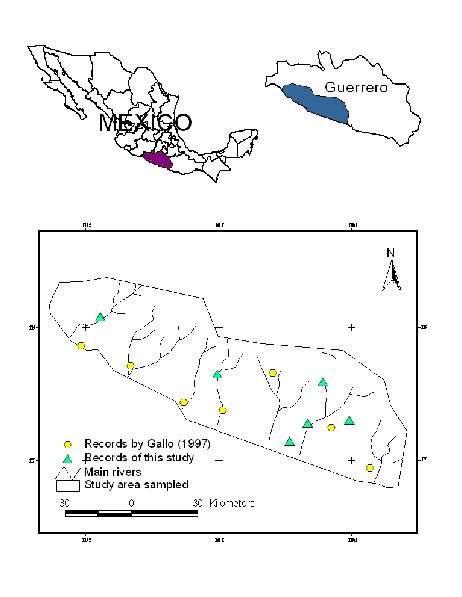 |
Last Update:
Thursday November 22, 2018
|
| [Home] |
|
Volume 20 Issue 2 Pages 58 - 90 (October 2003) Citation: Maldonado, J.R.E. and López González, C.A. (2003) Recent Records For The Neotropical River Otter (Lontra Longicaudis) In Guerrero, Mexico. IUCN Otter Spec. Group Bull. 20(2): 65 - 68 Recent Records For The Neotropical River Otter (Lontra Longicaudis) In Guerrero, Mexico Jiménez R. E. Maldonado1, C. A. López González2 1Unidad Académica de
Ecología Marina. Universidad Autónoma de Guerrero, Mexico e-mail: Cats4mex@aol.com Neotropical river otters (Lontra longicaudis) have an historical distribution from northern Mexico down to South America (LARIVIERE, 1999). This species has been recorded as associated with many vegetation types, and has been located at elevations between 300 to 1500 m (LARIVIERE, 1999). The quality of such habitats is characterized by sites with large amounts of riparian vegetation, which favors the abundance of den sites. The neotropical river otter has a low tolerance to environmental change, tending to occupy areas where water flow is constant and extensive, with low amounts of chemical and organic pollutants (LARIVIERE, 1999). The species is currently threatened along its distribution area, the main causes of population extinction being habitat fragmentation and poaching for fur (NOWAK, 1999). In Mexico, industrial waste spills into rivers have increased the amount of heavy metals, with a consequent increase in deaths of neotropical river otters (GALLO-REYNOSO, 1997). New neotropical otter records were obtained opportunistically whilst carrying out a field survey between August 2002 and April 2003. The study area was located in the southwestern portion of the Mexican State of Guerrero, encompasses an area of 11,594 km2, and includes the municipalities (local government entities) of Coyuca de Benítez, Atoyac de Álvarez, San Jerónimo de Juárez, Tecpan, Petatlán, Zihuatanejo and La Unión. These municipalities constitute the region known as Costa Grande, located between 17°00'-17°58' N latitude and 100°00'-101°45' W longitude (Fig. 1). The presence of neotropical otters was confirmed through interviews with ranchers, hunters and tanneries (LÓPEZ-GONZÁLEZ and BROWN, 2002; McNAB and POLISAR, 2002). Physical records (skins, skulls, and captive individuals) were documented through photographs. The records were plotted on a 1:250,000 map using ArcView 3.2a (ESRI 1999), creating a geographic information system that included vegetation (PALACIO-PRIETO et al., 2000), elevation and human settlement layers (CONABIO, 2003).
We obtained a total of 12 new records for neotropical river otters in the study area. These records represent the period from 2001-2003 (Table 1). Although neotropical river otters have been protected by the Mexican government since at least 1965 (SAG, 1965) the capture of five individuals for sale reflects an extant poaching problem within the region. Tanneries obtain a $40 dollar profit per skin processed, which usually means a 10-fold profit for the merchant (pers. obs.). Of the records, four were female, three male, and the rest were classified as unknown given that we were not able to verify either sex due to the poor condition of the specimen or lack of sufficient data provided by the informant. The records represented otters from four of the six municipalities surveyed, six for Atoyac, three for Zihuatanejo, two for San Jerónimo and one for Tecpan (Table 1). All records presented here are new localities when compared to the results of GALLO-REYNOSO (1997), reflecting possible range extension. Neotropical river otters were associated with six different vegetation types, from wetlands (popal-tular) to pine forest (Table 1), two records were detected in human influenced grasslands, probably reflecting transient individuals. Using GIS, we determined that otters were present in areas with 50.48 ± 116.62 humans/km2, and a settlement density of 0.14 ± 0.03 towns/km2. The average distance between records is 52.17 ± 39.87 km, the average distance from our records to Gallo-Reynoso is 22.09 ± 7.02 km. These measurements probably reflect the presence of several distinct populations within the study area. The sites around the town of Atoyac and La Zuzuca (San Jeronimo), however, probably represent a single subpopulation as they are 14.1 km apart, a linear distance that is easy to travel for otters. Although neotropical river otters remain a protected species in Mexico, their poaching and commercial use continuous to be detrimental for the extant populations. A special effort should be carried out to create a protected area in the Atoyac-San Jeronimo area that would shelter otters from further prosecution. REFERENCES CONABIO (2003). Geoinformación. <www.conabio.gob.mx>
Accesed12/09/2003. |
| [Copyright © 2006 - 2050 IUCN/SSC OSG] | [Home] | [Contact Us] |
